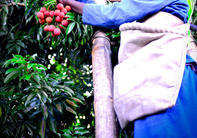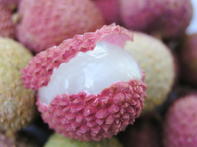Management practices in litchi farming depend on the management style, the intensity of farming, and on the cultivar. This can include fertilisation, irrigation, pruning, girdling, crop protection and post-harvest sulphur dioxide treatments.

More detailed advice can be found by joining litchi study groups and from reputable agricultural advisors. The South African Litchi Growers’ Association (SALGA) supports and manages litchi production and marketing in South Africa and can assist with advice on management practices for litchi.
Orchard Management Actions for Litchis
Litchi trees originate from the tropical forests of Southern China. In the subtropical production regions of South Africa, however, successful litchi production relies on irrigation. The type and frequency of irrigation can depend on tree age, climate and soil type. Both drip and micro-jet irrigation are used in South Africa.
Similar to irrigation, fertilization is one of the key factors for high litchi production. Newly transplanted trees should only be fertilised after they have produced their first leaf flush. For the first two years, fertilizer applications should be split in eight equal applications during the growing season (September to April). Thereafter applications are reduced.
Fertilisation for bearing trees is usually done after harvest, especially at post-harvest flush growth, before flowering and at fruit set when the litchi tree enters a water and nutrition demanding period. Fertilizer applications should be done according to soil and leaf analysis and plant nutritionists or agricultural advisers can assist with a fertilizer programme.
During fruit development, pest control measures should be applied to minimize crop losses due to litchi moth, false codling moth and fruit flies.
Fruit growth can be enhanced by adequate irrigation and fertilization as well as plant growth regulators and girdling during early fruit development. Likewise, proper irrigation and fertilization can reduce fruit drop and sunburn. Shade nets, covering the entire orchards, have been introduced in the litchi industry with good success and can reduce sunburn and minimize the effects of a harsh climate.
Covering of litchi fruit clusters with paper bags was done to prevent sunburn, fruit crack and damage from fruit flies, litchi moths, bats and birds. A labour-intensive procedure also causing quality issues such as mould and inadequate colouring, bagging has now been replaced by other management actions. These include proper fertilisation and watering to prevent sunburn and the use of nets to reduce bird damage.
Where necessary, post-harvest pruning should be done immediately after harvest, especially for late litchi cultivars. Fruit stalks left after picking should also be removed.
Litchi trees need to enter a resting phase (dormancy) before flowering to accumulate sufficient reserves for the flowering season. Withholding water from March to May, depending on the production area, may be used to enforce dormancy, but is not always effective depending on the climatic conditions, e.g. late rains in March and April. When applying water stress management, it is important not to allow the trees to dry out completely.
Any vegetative growth appearing during autumn or early winter will reduce or even prevent flowering and needs to be controlled by applying the plant growth regulator ethephon, which kills the young leaf flush and enables flower development once temperatures have dropped sufficiently enough.
Although not widely used, girdling of litchi trees can be done in mid-March after the post-harvest vegetative flush growth has hardened off to limit vegetative growth during the pre-flowering period. This treatment is not always effective enough to prevent new leaf flush in which case it needs to be followed up with ethephon applications.
Harvesting and Post-harvest Treatments for Litchis

Litchi is a non-climacteric fruit that does not ripen further once picked. Harvest maturity is determined by cultivar specific fruit colour, shape, skin texture and flavour. Total soluble solids (TSS) and titratable acid (TA) of the fruit pulp are determined and their ration calculated before harvest for a more accurate measure of maturity. The industry’s minimum standard for maturity is a TSS to TA ratio of 25:1.
Due to the uneven ripening of fruit within a cluster or tree, fruit is picked selectively at the start of the harvesting season. To ensure adequate fruit size the use of a fruit diameter measure (picking ring) is encouraged. Later in the harvesting season when all fruit has reached uniform ripeness, whole fruit clusters are picked. About 3 mm of the fruit stalk are left on the fruit to prevent skin splitting.
Litchi trees are generally picked with the help of ladders or automated picking trailers to access large trees. Picking is usually done during the coolest time of the day, preferably in the morning. In order to avoid desiccation and browning of the fruit skin, the harvested fruit must be kept cool all the time and crates should be covered by leaves or wet hessian in the orchard, during transport and at the packing shed.
During the harvesting process, damaged or stung fruit are presorted in the orchard and only healthy fruit is sent to the packing shed. In the packing shed, litchis are generally fumigated with sulphur dioxide, an antioxidant that prevents skin browning and limits fungal infections that will lead to a shortened shelf life. Fruit shipped out via airfreight is often additionally treated with organic acids after sulphur fumigation to allow for a quicker return of the reddish skin colour.
After fumigation and/or acid treatment, litchis are sorted by size. For both Mauritius and McLean’s Red the minimum fruit diameter for export is 30 mm and for the local market 28 mm.
Depending on the market, the fruit is packed in either 2 kg cartons or smaller plastic punnets. For long-term storage, cartons with litchis can be packed with a slow-releasing sulphur dioxide sheet on top of the fruit.
At room temperature, the shelf life of untreated litchi fruit is only a few days. However, when packed in sealed punnets and refrigerated at 4ºC, it can keep up to two weeks. Once treated with sulphur fumigation, fruit can last up to five weeks at 1ºC.
of up to two weeks when packed in sealed punnets and refrigerated at 4°C. At room temperature, shelflife is only a few days. Litchis will dry out and the skin will turn brown due to dehydration.
Limitations in Litchi Farming
Litchi production in South Africa is mostly hampered by inadequate yields caused by erratic flowering and low fruit set. However, with proper orchard management practices yield of up to 20 t/ha can be achieved.
Change of seasonal weather patterns due to climate change have an increasing impact on litchi production. Mitigating the effects of climate change through adapting orchard management practices will be the key to sustainable fruit production with good fruit quality in the future.
By Marinda Louw